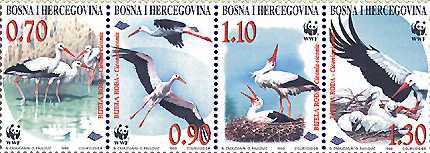Previous Years
1998 Issues
230 - Kiribati
231 - Mali
232 - Tirks & Caicos
233 - Lesotho
234 - Bosnia & Herzegovina
235 - Niuafo'ou
236 - Liberya
237 - Cyprus
238 - Australia
239 - Comoros
240 - Ukraine
241 - New Caledonia
242 - Cuba
243 - Somalia
244- Afghanistan
245 - North Korea
246 - Niger
247 - South Africa
1999 Issues
2000 Issues
2001 Issues
2002 Issues
For hundreds of years now, the European white stork has been nesting
close to people. They are not especially afraid of humans and can be
found nesting on chimneys, tall buildings, telephone poles, and even
structures specially built just for them.
They also nest in the usual places one might find birds, such as trees
or the
sides of cliffs.The European white stork is found throughout Europe
in
several distinct population groups, and one of these groups migrates
a great
distance yearly, from as far north as Denmark to as far south as South
Africa
- virtually all the way down the globe and back!
The European white stork is a large bird, an average of over 2 feet
tall and
weighing in at 10 lbs or more, with distinctive black and white feathers
and
a reddish beak and legs. Their vocalizations may sound like a gun firing
rapidly
and involve clattering their bills rapidly. They can live for 30 years
or more.
Their eggs, once laid, incubate for 30-50 days. Both male and female
share
nesting duties such as caring for the eggs and feeding the young. After
the
young have hatched, they are nest-bound for about 8 weeks before "fledging,"
i.e. leaving the nest.
There has been a severe decline in numbers in Europe since the II World
War
and the biggest concentration remains in the Iberian Peninsula.
However, it is generally well protected given the reputation it has
for being
a lucky bird. The myth about storks bringing babies probably arose
because
they arrived back in Europe on fairly predictable dates and almost
exactly
9 months after the previous mid-summer.

Animal: White Stork /Ciconia Ciconia
Iissue Date: May 05, 1998
Values: 0.7, 0.9, 1.1, 1.34 x 1won
Printing: 100 000
Printed in: sheets of 10 (5x2) &
mini-sheets of 4 sets (4x4)
Artwork: N. Chmajchanin
September -25 - 2002
Bosnia & Herzegovina stamps - Bosnia&Herzegovina Post Site
White Storks - White Storks Conservation In Poland
HOME Page
My Other Philatelic Interests
Collector's Corner
 ABOUT
THE HISTORY OF WWF LOGO
ABOUT
THE HISTORY OF WWF LOGO